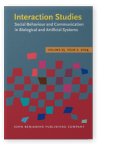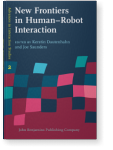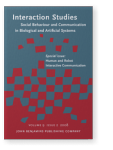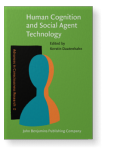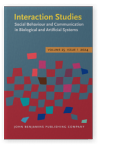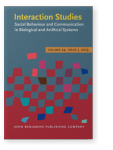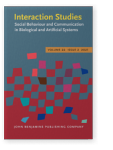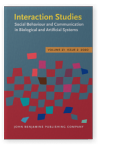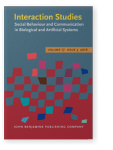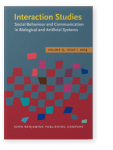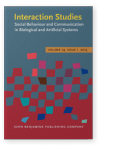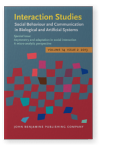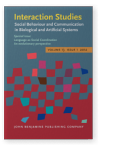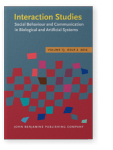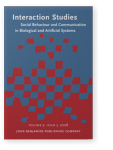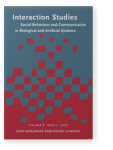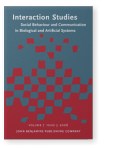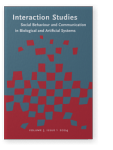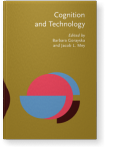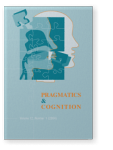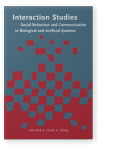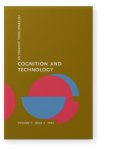Kerstin Dautenhahn
List of John Benjamins publications for which Kerstin Dautenhahn plays a role.
Book series
Journal
ISSN 1572-0373 | E-ISSN 1572-0381
New Frontiers in Human–Robot Interaction
Edited by Kerstin Dautenhahn and Joe Saunders
[Advances in Interaction Studies, 2] 2011. vi, 332 pp.
Subjects Computational & corpus linguistics | Interaction Studies | Sociology
Robots in the Wild: Exploring human-robot interaction in naturalistic environments
Edited by Kerstin Dautenhahn
Special issue of Interaction Studies 10:3 (2009) vi, 239 pp.
Subjects Cognition and language | Evolution of language
Human and Robot Interactive Communication
Edited by Kerstin Dautenhahn
Special issue of Interaction Studies 9:2 (2008) 232 pp.
Subjects Cognition and language | Evolution of language
Human Cognition and Social Agent Technology
Edited by Kerstin Dautenhahn
[Advances in Consciousness Research, 19] 2000. xxiv, 448 pp.
Subjects Consciousness research | Discourse studies | Philosophy | Pragmatics
2024 Towards accessible robot-assisted physical play for children with physical disabilities: MyJay, from user-centred design to an initial feasibility study Interaction Studies 25:1, pp. 36–69 | Article
MyJay is an open-source robot designed to facilitate play between children with and without physical disabilities. The robot acts as a proxy for children with upper limb challenges, allowing them to participate in physical games with their peers. Our design was inspired by the FIRST Robotics… read more
2023 A matter of consequences: Understanding the effects of robot errors on people’s trust in HRI Interaction Studies 24:3, pp. 380–421 | Article
On reviewing the literature regarding acceptance and trust in human-robot interaction (HRI), there are a number of open questions that needed to be addressed in order to establish effective collaborations between humans and robots in real-world applications. In particular, we identified four… read more
2021 Impact of nonverbal robot behaviour on human teachers’ perceptions of a learner robot Interaction Studies 22:2, pp. 141–176 | Article
How do we perceive robots practising a task that we have taught them? While learning, human trainees usually provide nonverbal cues that reveal their level of understanding and interest in the task. Similarly, nonverbal social cues of trainee robots that can be interpreted naturally by humans… read more
2020 Robot-Mediated Interviews: A field trial with a potential real-world user Interaction Studies 21:2, pp. 243–267 | Article
In recent years the possibility of using humanoid robots to perform interviews with children has been explored in a number of studies. This paper details a study in which a potential real-world user trialled a Robot-Mediated Interviewing system with children to establish if this approach could… read more
2016 Robot-Mediated interviews with Children: What do potential users think? Interaction Studies 17:3, pp. 438–460 | Article
To date research investigating the potential of Robot-Mediated Interviews (RMI) has focused on establishing how children respond to robots in an interview scenario. In order to test if an RMI approach would work in a real world setting, it is important to establish what the experts (e.g.… read more
2014 Robot companions for children with down syndrome: A case study Interaction Studies 15:1, pp. 99–112 | Article
We describe an exploratory case study about the applicability of different robotic platforms in an educational context with a child with Down syndrome. The robotic platforms tested are the humanoid robot KASPAR and the mobile robotic platform IROMEC. During the study we observed the effects KASPAR… read more
2013 Progress on evolution of communication and interaction studies Interaction Studies 14:1, pp. 1–6 | Article
2013 Where the action is: A conversation analytic perspective on interaction between a humanoid robot, a co-present adult and a child with an ASD Asymmetry and adaptation in social interaction: A micro-analytic perspective, Nomikou, Iris, Karola Pitsch and Katharina Rohlfing (eds.), pp. 297–316 | Article
This paper examines interaction involving a child with an Autistic Spectrum Disorder, a humanoid robot and a co-present adult. In this paper data from one child (collected as part of the ROBOSKIN project) is analysed in order to evaluate the potential contributions of a conversation analytic… read more
2012 Progress on evolution of communication and Interaction Studies Language as Social Coordination: An evolutionary perspective, Raczaszek-Leonardi, Joanna and Stephen J. Cowley (eds.), pp. vii–xvi | Article
2012 Scenarios of robot-assisted play for children with cognitive and physical disabilities Interaction Studies 13:2, pp. 189–234 | Article
This article presents a novel set of ten play scenarios for robot-assisted play for children with special needs. This set of scenarios is one of the key outcomes of the IROMEC project that investigated how robotic toys can become social mediators, encouraging children with special needs to… read more
2011 Introduction New Frontiers in Human–Robot Interaction, Dautenhahn, Kerstin and Joe Saunders (eds.), pp. 1–6 | Article
2009 Robots in the Wild: Exploring Human–Robot Interaction in Naturalistic Environments Robots in the Wild: Exploring human-robot interaction in naturalistic environments, Dautenhahn, Kerstin (ed.), pp. 269–273 | Article
2009 A long-term study of children with autism playing with a robotic pet: Taking inspirations from non-directive play therapy to encourage children’s proactivity and initiative-taking Robots in the Wild: Exploring human-robot interaction in naturalistic environments, Dautenhahn, Kerstin (ed.), pp. 324–373 | Article
This paper presents a novel methodological approach of how to design, conduct and analyse robot-assisted play. This approach is inspired by nondirective play therapy. The experimenter participates in the experiments, but the child remains the main leader for play. Besides, beyond inspiration from… read more
2008 Special Issue on “Human and Robot Interactive Communication” Human and Robot Interactive Communication, Dautenhahn, Kerstin (ed.), pp. 175–178 | Article
2008 Naturally occurring gestures in a human–robot teaching scenario Interaction Studies 9:3, pp. 519–550 | Article
This paper describes our general framework for the investigation of how human gestures can be used to facilitate the interaction and communication between humans and robots. Two studies were carried out to reveal which “naturally occurring” gestures can be observed in a scenario where users had to… read more
2007 Experimental comparisons of observational learning mechanisms for movement imitation in mobile robots Interaction Studies 8:2, pp. 307–335 | Article
Research into robotic social learning, especially that concerned with imitation, often focuses at differing ends of a spectrum from observational learning at one end to following or matched-dependent behaviour at the other. We study the implications and differences that arise when carrying out… read more
2007 Are robots like people? Relationships between participant and robot personality traits in human–robot interaction studies Interaction Studies 8:2, pp. 281–305 | Article
Identifying links between human personality and attributed robot personality is a relatively new area of human–robot interaction. In this paper we report on an exploratory study that investigates human and robot personality traits as part of a human–robot interaction trial. The trials took place… read more
2006 Does appearance matter in the interaction of children with autism with a humanoid robot? Interaction Studies 7:3, pp. 479–512 | Article
This article studies the impact of a robot’s appearance on interactions involving four children with autism. This work is part of the Aurora project with the overall aim to support interaction skills in children with autism, using robots as ‘interactive toys’ that can encourage and mediate… read more
2004 Towards robot cultures? Learning to imitate in a robotic arm test-bed with dissimilarly embodied agents Interaction Studies 5:1, pp. 3–44 | Article
The study of imitation and other mechanisms of social learning is an exciting area of research for all those interested in understanding the origin and the nature of animal learning in a social context. Moreover, imitation is an increasingly important research topic in Artificial Intelligence and… read more
2004 The origins of narrative: In search of the transactional format of narratives in humans and other social animals Cognition and Technology: Co-existence, convergence and co-evolution, Gorayska, Barbara and Jacob L. Mey (eds.), pp. 127–152 | Article
2004 Editorial Interaction Studies 5:1, pp. 1–2 | Miscellaneous
2004 Towards interactive robots in autism therapy: Background, motivation and challenges Pragmatics & Cognition 12:1, pp. 1–35 | Article
This article discusses the potential of using interactive environments in autism therapy. We specifically address issues relevant to the Aurora project, which studies the possible role of autonomous, mobile robots as therapeutic tools for children with autism. Theories of mindreading, social… read more
2004 Robot-mediated joint attention in children with autism: A case study in robot-human interaction Interaction Studies 5:2, pp. 161–198 | Article
Interactive robots are used increasingly not only in entertainment and service robotics, but also in rehabilitation, therapy and education. The work presented in this paper is part of the Aurora project, rooted in assistive technology and robot-human interaction research. Our primary aim is to… read more
2003 Chapter 4. Stories of lemurs and robots: The social origin of story-telling Narrative Intelligence, Mateas, Michael and Phoebe Sengers (eds.), pp. 63–90 | Article
2002 The origins of narrative: In search of the transactional format of narratives in humans and other social animals International Journal of Cognition and Technology 1:1, pp. 97–123 | Article
This article presents work in progress towards a better understanding of the origins of narrative. Assuming an evolutionary and developmental continuity of mental experiences, we propose a grounding of human narrative capacities in non-verbal narrative transactions in non-human animals, and in… read more
2000 Introduction Human Cognition and Social Agent Technology, Dautenhahn, Kerstin (ed.), pp. xv–xxiv | Miscellaneous
2000 16. Living with Socially Intelligent Agents: A Cognitive Technology view Human Cognition and Social Agent Technology, Dautenhahn, Kerstin (ed.), pp. 415–426 | Chapter
1997 Remembering, Rehearsal and Empathy: Towards a social and embodied cognitive psychology for artifacts Two Sciences of Mind: Readings in cognitive science and consciousness, Ó Nualláin, Seán, Paul Mc Kevitt and Eoghan Mac Aogáin (eds.), pp. 257–282 | Article

